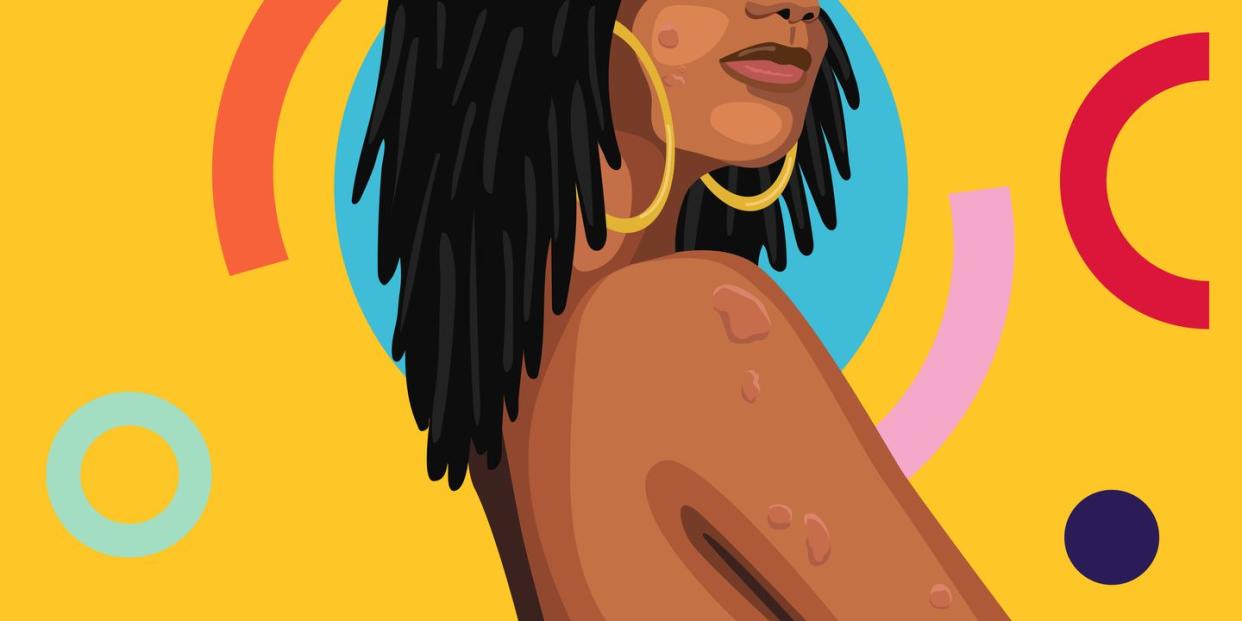Hives Don’t Always Look Red On Black People’s Skin

The skin, while acting as a protective barrier to everything you’ve got going on inside your body, is also often the first responder alerting you when something concerning is going on inside your body. And hives, or urticaria as they’re officially called, are one of those signalers.
Most people imagine hives to be itchy swollen red bumps or welts that creep up on your body. However, Black people with dark skin tones on which redness is tough to spot might have a harder time identifying the condition compared to those with lighter skin tones often pictured in medicine and research.
In fact, even the pros might miss it. According to a 2020 study in which 177 medical students were asked to identify various conditions on skin of color, 57.5% properly identified hives. And while the lesions tend to go away pretty quickly—“they last a couple of hours, [in most cases] no longer than a day in the spot where they appear,” says board-certified dermatologist, Sophia Reid, MD—an inability to diagnose them while they're visible means missing out on the cause. As a result, you'll likely eat the food, take the medication, or expose yourself to the environment that triggered them again and again.
Leaving hives to regulate themselves is usually not a biggie. But in more severe cases, it’s important to know when you need treatment and whether the hives might have been preventable in the first place. For this to happen, you'll need to know what hives look like on you. And for Black people, that calls for familiarity with a condition that might otherwise go undiagnosed, misdiagnosed, unchecked, or untreated as a result of healthcare disparities that often don't take into account differences in skin color. Ahead, two dermatologists explain everything you need to know about hives on Black skin.

What are hives, exactly?
Hives are an allergic reaction. "Hives are swollen, itchy, less frequently painful or sore, raised, sometimes blanchable welts or bumps that can occur anywhere on the skin," says Hope Mitchell, MD, a board-certified dermatologist in Ohio. (FYI, something's blanchable if you can press down on it and push the blood from the surface and discolor it for a moment).
There are two classifications of hives, says Dr. Reid. The first, called acute hives, go away pretty quickly and tend to stick around for fewer than six weeks. Sometimes someone might even just get one or two hives rather than a large rash covering a large portion of their body. Chronic hives, on the other hand, last for more than six weeks and tend to recur until the reaction has run its course. In these cases, the hives could cover someone's entire body.
What causes hives?
Hives are typically caused by allergies to food, bug bites, medications, topical products, infections, and stress, says Dr. Reid. "Extreme emotional responses can bring them on," she adds. The earlier you can detect hives, the easier it is to determine the trigger. "However, the longer the hives persist, it may be difficult to determine the cause," says Dr. Mitchell.
What do hives look like on Black people’s skin?
On Black skin, what is often described as red, swollen bumps usually take on a deeper, almost purple color, says Dr. Reid. The swelling can sometimes even make the surrounding skin appear lighter in comparison while the center of the bump will have, what Dr. Reid calls a peau de orange appearance, like the skin of an orange peel.
And in some cases, other than seeing the raised skin, there is no indicative color at all. Hives can sometimes blend into dark skin tones, says Dr. Mitchell.
How do you prevent and treat hives on Black people’s skin?
"Identifying your trigger is the key to prevention," says Dr. Reid. This can get tricky since each person reacts to triggers differently. Your best bet is asking for your doctor's help figuring out whether it's food, a medication, a fragrance, a lotion, stress, or insect bite. You might even be asked to patch test with the topical product you use, to see if your skin reacts to it. Otherwise, says Dr. Mitchell, your doc might do some bloodwork to rule out a possible infection.
"For some who react strongly to bug bites, for example, using bug repellant before outdoor activities are helpful to prevent hive formation. The brands I prefer are OFF! Deep Woods Insect Repellent or REPEL Plant-Based Insect Repellent," says Dr. Reid. If the issue is a lotion, oil, detergent, or ointment you've been rubbing into your skin, fragrance-free alternatives are your best bet. Dr. Mitchell suggests looking out for products with pramoxine, camphor, or menthol, such as Sarna lotion, Cerave Itch Relief Moisturizing Cream, and hydrocortisone creams such as Cortizone-10. You might also try lotions with aloe and Cicalfate creams.
Like most allergic reactions that are tame enough to treat at home, an antihistamine will do the trick, regardless of skin tone. Dr. Reid typically recommends Benadryl, Zyrtec, Xysol, Allegra, and Benadryl topical gel. "My go-to routine is Zyrtec in the morning and if needed, a Benadryl at night," she says.
And in some cases, your doc might recommend a prescription medication such as cortisone cream or an oral steroid, particularly if the cause is stress or emotional trauma. "But if your hives last longer than 24 hours in the same spot, or don't resolve after six weeks then those are reasons to visit your doctor because there may be a more serious underlying medical condition," says Dr. Reid.
You Might Also Like

